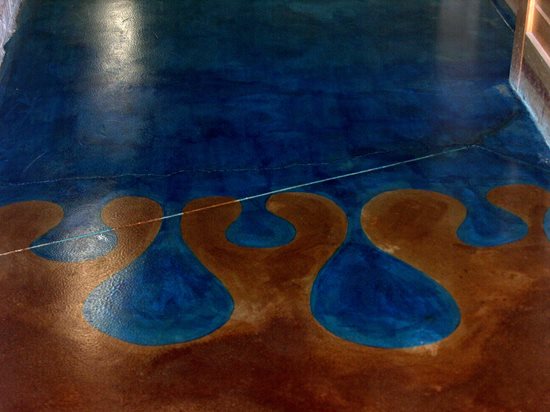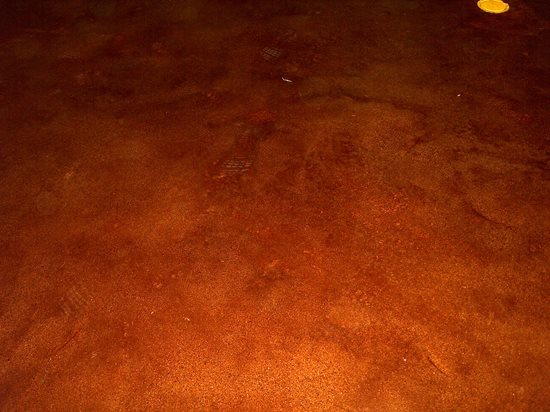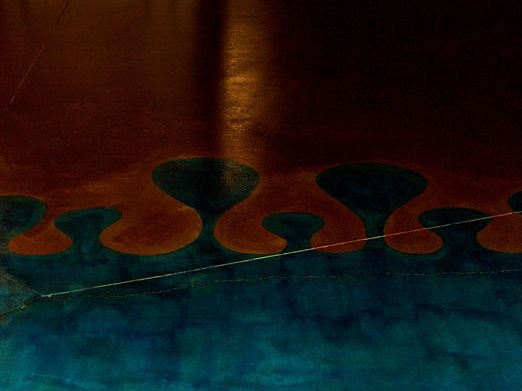Decorative concrete dream jobs usually consist of great clients, easy access to the work site, excellent (controlled) conditions, and the availability of necessary products.
But what happens when things don't go your way?
For Tim Bales, owner of Bales Concrete LLC in Lewis Center, Ohio, a recent job he bid, thought to be a four day job, turned into a four-week job, one in which almost everything that can go wrong did.
Yet, in spite of everything, the floor Bales created not only wowed the client, but also speaks to his work ethic, skills, and dedication to making the decorative concrete industry last.
The client, who found Bales through the Concrete Network, owns a large, well-appointed 10,000+-square-foot home in New Albany, Ohio, and had only specified acid stained floors for 2,600 square feet of basement.
Although Bales did everything right—asking the homeowner if there was any paint on the existing concrete slab, as well as testing a few inconspicuous spots onsite himself, little did he know that there was light grey paint on the floor, which was nearly impossible to see with the naked eye.
What Bales did know about the floor was already complicating matters, as the floor was radiant heat. In addition, there was no access to drains, so any liquid would have to be dealt with not only quickly, due to the heat from the floor, but also in small doses, as it would have to be removed from the premises by hand. The last wrinkle in the project was the fact that the clients were living in the dwelling during all phases of the work, which is not the norm in most cases.
Bales says once he set to work, he realized that although the spots he had tested had no paint, there was in fact paint on the existing slab that needed to be completely removed. "Once we realized there was paint on the floor, which was pretty quickly, we used a six-stone grinder to remove as much of the paint as we could," Bales says. But because the homeowners were also onsite, Bales adds that he had to keep the dust down by running water while grinding and using an air scrubber.
After the first grinding, Bales wet the floor and then had to grind the whole floor yet again to get the last remnants of paint off. For this step, he used a hand grinder with a Shop Vac attachment to catch the dust, as well as relied on the air scrubber to remove any airborne dust particles.
"There were a couple of times that the homeowner asked us to stop due to the dust, so in all the grinding process took about two and a half to three weeks," adds Bales, noting that as soon as he realized the job would be much trickier than first anticipated, he and the homeowner came to an agreement that the client would cover the cost of all equipment, and Bales would cover any labor above and beyond the initial bid.
After every spec of paint was removed from the floor, Bales set about removing the concrete residue with water, brushes and squeegees, a time consuming process as there were no drains. "We had to do it two gallons of water at a time and Shop Vac the water up," Bales notes with a wry laugh.
While this particular job did pose unique challenges, Bales says he relished the fact that the clients relied on his artistic abilities.
"The clients were really open to our creative input," explains Bales, "and, as can happen over the course of days or weeks, the direction of the project even changed while we were there. Originally, they were really into brown colors, and the main room was done in a brown acid stain. But for the other room, he changed his mind and decided he wanted it to look like water, so we changed our approach."
The brown Bales used, Butterfield Perma-Cast® Sierra StainÔ in Cordovan Leather, created a weathered effect like that of well-worn leather. For the "water" aspect of the floor, Bales used Brickform's Blush-Tone Acid Stain in Turquoise.
The meeting of the colors was all done free hand with brushes, because there was a tight radius for the "water drops." And to create the depth in the water-like effect, Bales says he applied the acid stain and then pulled it back with sponges and towels.
While the radiant heated basement floor is certainly a great feature for the clients, for Bales it created yet another issue. "Any time we had residue to rinse, we had to be quick before it dried," he explains. "The concrete was very porous and there was no moisture content, so if we put down two gallons of water, we'd only have 10 to 15 minutes to clean it up."
But clean it up he did, and after that, he neutralized the floor with baking soda and water. Of course, this process also involved removing the residue, which was again accomplished in two-gallon increments that were then shop vacuumed up.
To make sure the color had set, which ensures the life of the floor, Bales then tested sections all over the floor with a white cloth. "If any color came off, any hint of color, we had to clean it all over again, which we ended up having to do," laughs Bales.
Ensuring the beauty of his work, Bales then sealed the floor with rollers and Scofield® Cureseal-SÔ, a product designed for curing and sealing colored or uncolored concrete and sealing new or old, interior or exterior concrete flatwork where a clear matte or gloss finish is desired.
"Lack of access to a floor drain also necessitated this process be completed in 20 by 20 increments, and we controlled the sealer with the cuts on the floor," adds Bales. "Because it was a porous floor, it sucked up a lot of sealer, so we had to keep applying it until it stayed on top of the concrete to create that shiny look. In all, it took about one day to seal, and we used 20 gallons of sealer."
When all is said and done, Bales says he doesn't regret the project and is using it as a growth experience.
"I learned to test a floor in more areas, not just in inconspicuous spots," he concludes. "This project posed very unusual circumstances—no floor drain, the clients were living on the premises, and existing paint on the floor. Any one of those aspects can derail a project, and we had to deal with all of them, which we did. I'm very hands-on and very picky, both of which helped ensure that the clients were happy and I produced something I'm proud of."
Proving that he's up to any challenge, Bales has recently set his sights west. Bales Concrete LLC, which has been in business since 2000, plans to open a division in Los Angeles where "there is a definite need for this type of work." Both the existing location and the new location will specialize in residential and commercial exterior and interior decorative concrete, with Bales commuting to both areas, providing his artistic ability as required.
And Bales will be sure to test the floor of any prospective job thoroughly next time, whether it's in the West or Mid-West.
Tim Bales
Bales Concrete LLC
3556 Greenville Drive
Lewis Center, Ohio 43035
614-668-0038
balesconcrete@yahoo.com
www.balesconcrete.com


